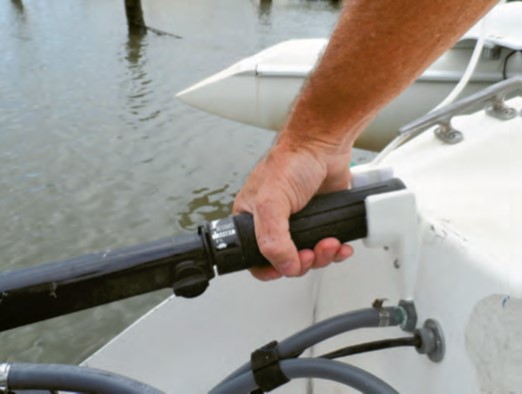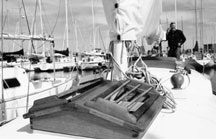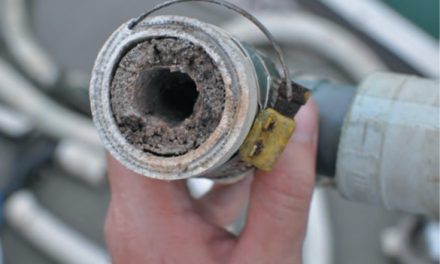A bracket fabricated from Coosa board keeps an outboard tiller out of mischief.
Issue 136: Jan/Feb 2021
The outboard tiller had been bothering me for a while. The friction lock on the engine side—the one that prevents the tiller from rotating—couldn’t be tightened, a victim of corrosion. And even if it could be tightened, I probably wouldn’t use it; it was difficult to reach, and I occasionally needed to quickly move the tiller to swing the engine around, as when entering an awkward slip.
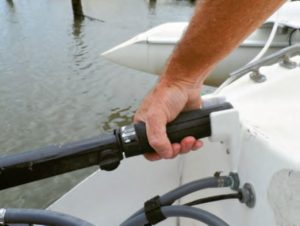
The bracket restrains the tiller handle but still allows easy accessibility.
Thus, the tiller constantly rubbed on the cockpit gelcoat. Sooner or later, it would wear through. I needed a place to securely park the outboard tiller but still be able to grab it and move it at will. The solution: a bracket.
The ideal shape I envisioned was three-dimensionally complex and didn’t lend itself to straightforward fabrication. I sought an elongated trough, like a half pipe or cup, to support the handle and keep it in place without damaging the rubber cover. The trough had to be mountable where I wanted the handle to lie—a few inches above and an inch aft of the nearest bulkhead—and it had to angle slightly downward and inboard to accommodate the tiller angle.
I considered materials. Metal invited corrosion issues and would require padding to prevent damage to the rubber covering. I could carve it from laminated wood using common power tools, but the grain would pose a challenge and there was rot risk to mitigate. Foam could work, but even high-density foams have no flexural strength, and the requisite fiberglassing would complicate construction.

The tiller holder installed. Note the worn area just to the right where the tiller had been rubbing.
Fortunately, I had a few scraps of Bluewater 26, made by Coosa Composites and commonly called Coosa board. This is a high-density, closed-cell, polyurethane foam reinforced with woven roving and continuous-strand fiberglass. Coosa board possesses many positive characteristics of foam, fiberglass, and wood. It is similar in strength to plywood in some ways and far stronger than foam. With no grain, it’s easy to carve and cut accurately. It bonds well, doesn’t rot, and is lightweight.
So, I set about fabricating and constructing my tiller holder. The two scraps of Coosa board were of different thicknesses, one 3/8-inch thick, the other 1-inch thick. I resolved first that the 3/8-inch piece would become the leg and the 1-inch piece the trough.
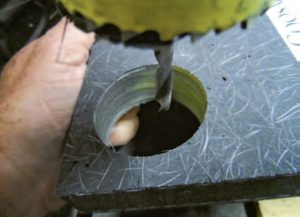
Coosa board drills and saws like a soft, grain-free wood. The cuts are accurate and clean.
Using a hole saw mounted to a drill press, I cut a 1½-inch-diameter hole in each piece. Before drilling, I blocked and clamped the boards so they were oriented to give the trough the slight inward and downward angles I needed (I did not drill perpendicular to the material surface).
I next cut the 3/8-inch piece to rough size with a portable bandsaw, leaving about 1/8-inch extra in every dimension for sanding. Cutting the 1-inch piece was trickier, following the curve of the hole I’d drilled to create the C-shaped piece that would form part of the trough.
Next, I rounded and smoothed that outside curve using a disk sander and finish sander. I felt it was important to spend time on these parts now because this shaping and smoothing would be much more difficult after assembling and bonding the pieces. Satisfied, I bonded the two parts with slightly thickened epoxy.
Once the epoxy cured, I smoothed and blended the inside of the trough using a 1-inch diameter sanding drum chucked in a drill press. I carefully shaped the sides of the mounting leg with a disk sander and then hand-sanded the entire assembly to remove sharp corners and to blend the curves. I used thickened epoxy to fillet the inside corner between the trough and the leg.
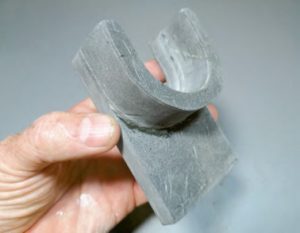
Although this could be laminated from plywood and shaped, the grain would reduce strength, it would be heavier, and it would eventually rot.
As it was, the tiller holder I’d created was very strong, but it would be installed where it was likely to be stepped on or kicked, so I wanted it tough. Additionally, although Coosa board is dense, it’s not impervious to denting. For these reasons, I covered the entire tiller holder with a single layer of 6-ounce fiberglass finish cloth, cut and glassed in multiple small pieces to fit the varying contours of the holder.
After this layer of fiberglass cured, I sanded everything smooth, drilled mounting holes, gave the piece a final coat of epoxy, and applied three coats of Interlux Brightsides marine polyurethane. Self-tapping screws held the tiller holder to the bulkhead while the polyurethane sealant between the two surfaces cured.
The finished tiller holder weighs less than an ounce, looks like a factory fitting, and will last as long as the boat.
Good Old Boat Technical Editor Drew Frye draws on his training as a chemical engineer and pastimes of climbing and sailing to solve boat problems. He cruises Chesapeake Bay and the mid-Atlantic coast in his Corsair F-24 trimaran, Fast and Furry-ous, using its shoal draft to venture into less-explored waters. He is most recently author of Rigging Modern Anchors (2018, Seaworthy Publications).
Thank you to Sailrite Enterprises, Inc., for providing free access to back issues of Good Old Boat through intellectual property rights. Sailrite.com

